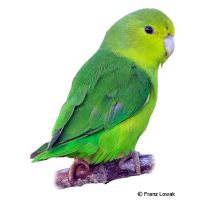Blue-winged Parrotlet (Forpus xanthopterygius)
| Blue-winged Parrotlet Forpus xanthopterygius | |
|---|---|
| Name | Blue-winged Parrotlet |
| Name Lat. | Forpus xanthopterygius |
| Family | Parrots |
| Family lat. | Psittacidae |
| Order | Parrots |
| Order lat. | Psittaciformes |
| Origin | South America |
| Climate | Subtropical - tropical |
| Diet | Large Parakeet seed, veggies, fruits |
| Keeping | Pair, group |
| Care Level | Moderate |
| Reproduction | Cavity nest |
| Life Span | 10-15 years |
| Protection | CITES Appendix II; EC Annex B |
| Metric Units | |
| Size | 12 cm |
| Temperature | Room temperature |
| Housing | 100 x 50 x 50 cm |
| US Units | |
| Size | 4.7" |
| Temperature | Room temperature |
| Housing | 40" x 20" x 20" |
Distribution and habitat
The range of the blue-winged sparrow parrot is eastern Brazil, northern Colombia, the upper Amazon River basin, Bolivia, and Paraguay, where they live in dry areas of scrub, trees, and rainforest edges.
Cage size
The minimum cage size is 100 x 50 x 50 cm (L x W x H) for a pair. The cage size must not be undercut even in case of justified single keeping. For an additional 2 birds, assuming species compatibility, the floor space must be increased by 50%. The cage must be placed at a height of at least 80 cm (except aviaries) in a bright, draught-free and quiet place and should have cross-wiring or netting. Keeping in an aviary with a floor area of at least 1 m² is preferable to keeping in a cage.
Maintenance
The floor must be covered with sand, shavings of untreated wood or similar material and cleaned once a week if possible. At least 2 perches made of wood or branches of different thickness and height are to be installed in such a way as to provide the longest possible flight path. A bathing opportunity should be available at all times, alternatively they can be sprayed with water at least once a week. In addition to hiding places (burrows or half burrows), they need climbing and occupation material, such as rings, ropes and natural branches that are harmless to health. They should be kept at room temperature.
Diet
The species-specific food offer consists of mixed seeds, available in specialized trade as "large parakeet food" in premium quality, supplemented with cob millet, green food (dandelion, chickweed, green millet), vegetables (peppers, carrots, etc.), fruit, berries, wild herb seeds, occasionally insect food (meal beetle larvae, crickets) and especially for raising young sprouted seeds (wheat or corn) and soft food. They need grit, cuttlefish and vitamin lime as digestive aids. Water must always be available in birdbaths or in stable, open containers. Feed and water must be offered fresh daily, and the containers must be cleaned beforehand.
A varied diet promotes health and prevents deficiency symptoms.
Reproduction and breeding
The sexes are easily distinguished, the females do not have blue plumage.
They breed in nest boxes (e.g. budgie nest boxes) in portrait or landscape format and in hollowed tree trunks. Sawdust or wood mulch is suitable as nest box bedding. The clutch consists of 3-5 eggs, the incubation period is about 21 days. During the breeding season they may be kept only in pairs (not in a group). Young birds should be raised so that they are species-specific.
Species protection
They should be provided with a leg ring. The animal population must be reported in writing to the competent authority immediately after the start of keeping. Your pet store will be happy to provide you with further information.
Protection of species: WA Appendix II; EU Appendix B. The proof of purchase is the required proof of origin for the animal. Please keep it safe!
Important
In the case of outdoor aviaries, they also need a heated shelter of at least 0.5 m², which can be visited by the birds at any time. The temperature in the shelter must not fall below 15 °C and the furnishings must correspond to those of cage keeping
There are numerous color mutations, since all species of the sparrow parrots can cross fertilely
They may only be kept in pairs or in a group. A socialization with other small parrots is well possible. In rooms, also in shelters, sufficient daylight or flicker-free artificial light (stroboscopic effect) corresponding to daylight should be provided. The lighting duration shall be 8-12 hours per day and the natural day-night rhythm shall be observed. Adequate indoor climate should be provided. If caged, they should be allowed free flight. The health condition of the birds should be checked daily.
Further literature can be found in your pet store.
References
Text: Othmar Sieberer; Image: Franz Lowak
Source: BMELV (1995): Tierschutzgutachten - Mindestanforderungen an die Haltung von Papageien; ARNDT (1997): Lexikon der Papageien, Arndt Verlag; GRUMMT & STREHLOW (2009): Zootierhaltung - Tiere in menschlicher Obhut: Vögel, Verlag Harri Deutsch
- Gemäß § 21 Abs. 5 Tierschutzgesetz idgF
